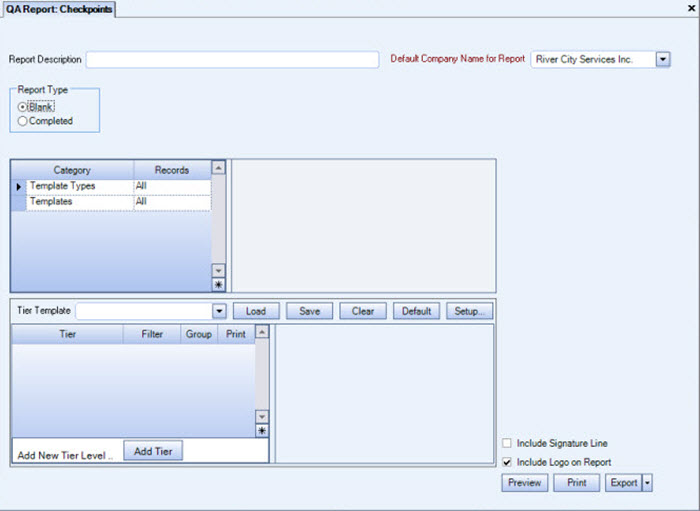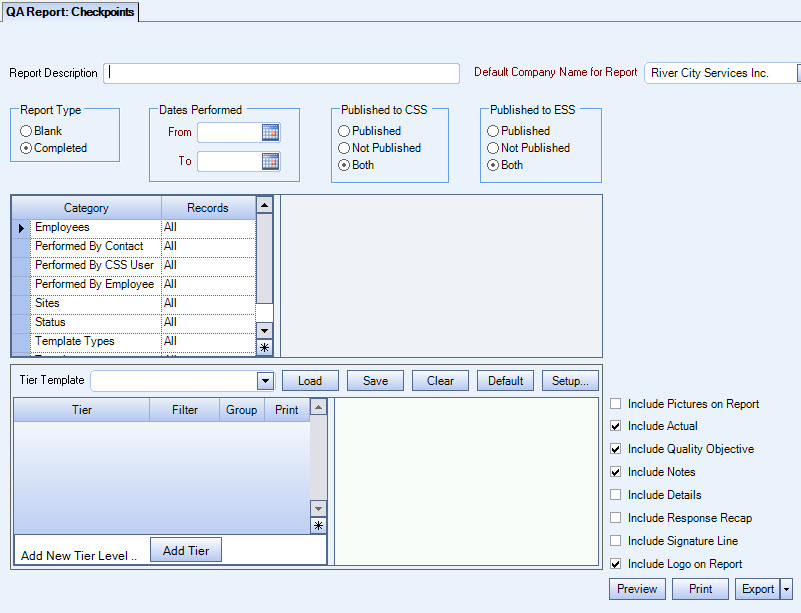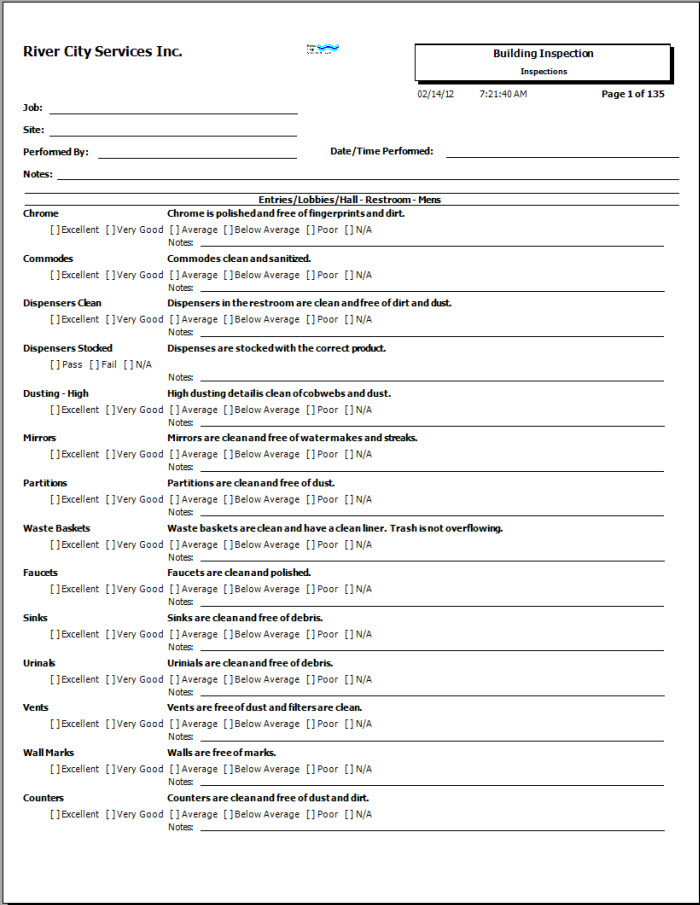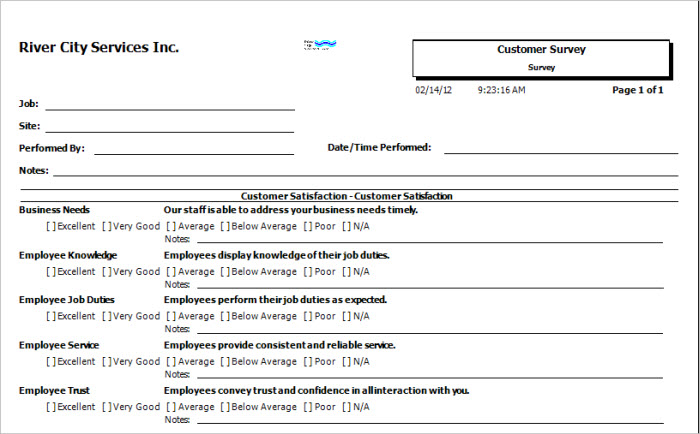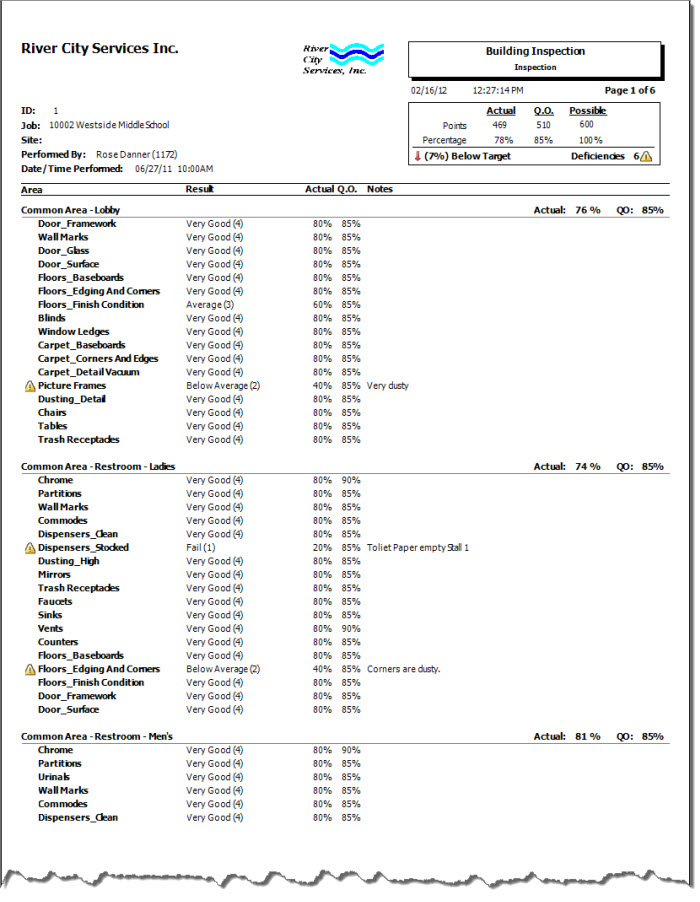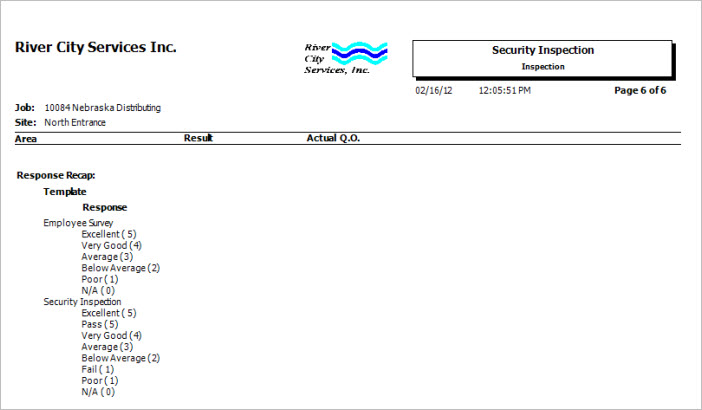Overview
You can run the Checkpoint Report using Blank Checkpoints or Completed Checkpoints. Blank Checkpoints are typically used when you need a hard copy to perform the Checkpoint. Completed Checkpoints include both Completed and Modified Checkpoints.
You can filter, group, and print by Tiers, allowing for total customization of the report. To make filtering easier, for any Tier, you can include All, Pick/Create or Exclude parameters. Using Tier Templates to set up and save report templates makes it easy to generate a specific report each time you need it, without having to recreate the criteria. See Using Tier Templates for more information.
The Checkpoint Report print the areas in the same order as they appear on the Checkpoint Templates screen. The report can also include a signature line which prints on the last page for the Job.
Key Functionality
Type a description to name the report. This description prints above the Report Title.
The Default Company Name for Report is populated from the Company Setup screen. The list contains all companies for which you have security permissions to view. If you have permission for only one company, that will be the only one displayed in the list. If you have permissions to multiple companies, the list will display those companies PLUS the default reporting company.
When discernible, WinTeam will print the appropriate company name and logo on each page; otherwise the Default Company Name will print. That is, if a Company level is included in the tiered section and is displayed in the tiered information at the bottom of the page, then that company's Report Name and Logo (if selected) prints on that page.
If there is not a Company identified in the tier area of the page, then the Default Company Name for Reports is used. The default Company Name and Logo is also used for the Total Enterprise report. For more information see Learning about WinTeam Reports.
Select either a Blank or a Completed Report Type. The default selection is Blank. If Completed is selected, additional options are available.
This option is available when the Report Type is Completed. Enter a range of dates on which Checkpoints were performed.
Completed reports can be published to CSS and/or ESS.
Performed by Contact
Use the Performed By Contact category to filter the report by the Contact who Performed the Checkpoint.
Select All to include all Contacts.
Select Pick to define specific Contacts. Select the check box next to each Contact to include.
This Category is available when the Report Type is Completed.
Performed by CSS User
Use the Performed CSS User to filter the report by the CSS User.
Select All to include all Checkpoints, regardless of who performed it.
Select Pick to define specific CSS Users. Select the check box next to each CSS User to include.
This Category is available when the Report Type is Completed.
Performed by Employee
Use the Performed By Employees to filter the report by the Employee who Performed the Checkpoint.
Select All to include all Employees.
Select Range to define a range of Employees. When you select Range, the range fields display. Type the beginning Employee Number in the From field and the ending Employee Number in the To field.
Select Create to define your own list of Employees. When you select Create, a small grid displays to the right. Enter the Employee Numbers you want to include in the list, or use the Lookup to locate the Employee Numbers.
Select Exclude to identify records that should not be included. When you select Exclude, a small grid displays to the right. Enter the Employee Numbers you want to exclude in the list, or use the Lookup to locate the Employee Numbers.
This Category is available when the Report Type is Completed.
Sites
Use the Sites Category to filter the report by Sites.
Select All to include all Checkpoints, regardless of the Site.
Select Pick to define specific Sites. Select the check box next to each Site to include.
Only the Sites that fall within the selected criteria display in the Pick List.
This Category is available when the Report Type is Completed.
Status
The Status Category is applicable for Completed Checkpoints.
Use the Status category to filter the report by Checkpoint status.
Select Completed to include Checkpoints that are marked Completed.
Select Modified to include Completed Checkpoints that have been Modified.
This Category is available when the Report Type is Completed.
Template Types
Use the Template Types category to select the Template Types to include on the report.
Select All to include all Template Types.
Select Pick to define specific Template Types for the report. When you select Pick, the Template Types list displays. Select the check box next to each Template Type to include on the report.
Templates
Use the Templates category to select the Templates to include on the report.
Select All to include all Templates on the report.
Select Pick to define specific Templates for the report. When you select Pick, a list of active Templates displays. Select the check box next to each Template to include the on the report.
Use the Tier Template to define and save customized settings for a report. To use an existing template, select the template from the list and click Load.
To create a new template, you can load an existing template, make the necessary modifications, click Save, and define a new template name in the Save As dialog box. Alternatively, you can start with a blank template by clicking the Clear button.
To modify an existing template, load the template, make the necessary modifications, and then click Save. The name of the existing template display in the Save As dialog box. Click OK.
For more information see Using Tier Templates and Using Tier Parameters.
Select the Include Pictures on Report check box to show pictures at the end of each Checkpoint on the report. This is useful when you want to be able to easily show clients pictures of reported deficiencies.
Pictures will appear in two columns so that it is easy to identify which images apply to a Checkpoint and which images apply to a Checkpoint Item.
This check box is available when the Report Type is Completed.
Select the Include Actual check box to have the Actuals from the Completed Checkpoint included on the report.
This check box is selected by default.
This check box is available when the Report Type is Completed.
Select the Quality Objective check box to have the Quality Objective percentage print on the report. QO is included for all levels, Items, Areas, Sections and the overall Checkpoint. This check box is selected by default.
Select the Include Notes check box to include Notes from a Completed Checkpoint.
This check box is selected by default.
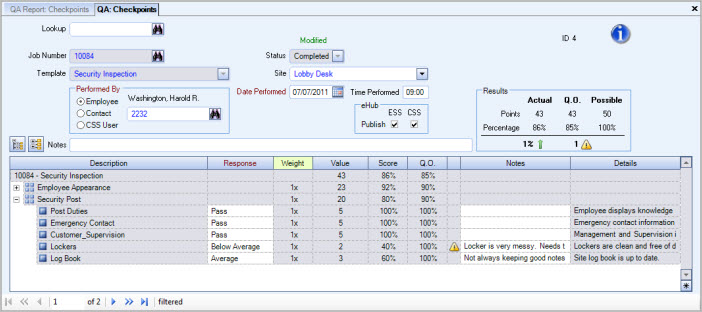
Select the Include Details check box to include the Details from the Items record.
Select the Include Response Recap check box to include a summary of the Checkpoint results on the report. This check box is not selected by default.
Select the Include Signature Line check box to have the signature line print on the report. This is not selected by default.
Select the Include Logo on Report check box to print the company logo on the report. This check box is selected or cleared by default, based on the option selected in SYS:Defaults. However, you can modify the setting on each report.
Preview
Click the Preview button (or use the shortcut key, ALT + V) to view the report before printing.
Click the Print button (or press ALT + P) to send the report to your default printer.
Export
Click the Export button (or press ALT + X) to export the report to a specified format. Reports may be exported to Adobe Acrobat (PDF), Excel, Comma-Separated Values (CSV), Grid View and E-mail (available for premise-based clients only).
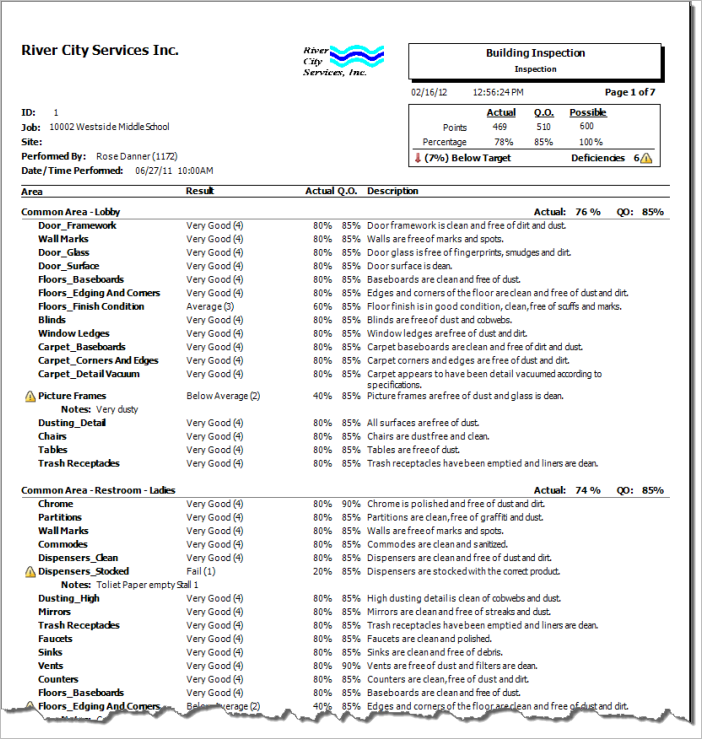
Related Information
The QA Report Checkpoint Report screen is part of the QA Reports ALL Security Group.
Tip: For more information see Security Groups Overview and Security Groups By Module.

